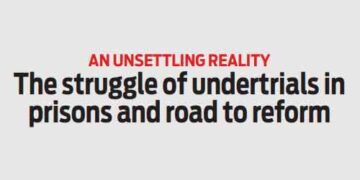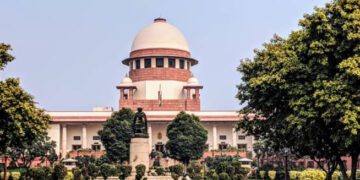 At the heart of any robust criminal justice system lies the golden thread of ‘innocent until proven guilty.’ Yet, this crucial principle often falls prey to a strained and overburdened judiciary in India.
At the heart of any robust criminal justice system lies the golden thread of ‘innocent until proven guilty.’ Yet, this crucial principle often falls prey to a strained and overburdened judiciary in India.
This results in countless individuals, primarily from disadvantaged backgrounds, enduring prolonged periods as undertrials in prisons.
This article seeks to shed light on the grim situation of undertrials in India, the reasons behind their extended detention, the repercussions of this predicament, and potential solutions.
The present state
According to the National Crime Records Bureau’s Prison Statistics India report, undertrials comprised nearly 70 per cent of the total prison population in India as of 2020. This startling percentage paints a vivid picture of delayed trials and a slow judicial process. Often, undertrials spend more years in prison awaiting judgement than they would serve if convicted.
The stark reality was underscored by Chief Justice of India DY Chandrachud, who noted the prolonged duration undertrials languish in prisons due to their inability to afford the funds required to pursue their cases.
The CJI, while addressing the inaugural event of the new building of the Jharkhand High Court on May 24, alsohighlighted that delay in undertrial cases leads to erosion of trust in the justice delivery system.
He stressed that the district judiciary needed to be at par with higher courts and this would help augment the prestige of the citizens.
Reasons behind surge The surge in undertrial population can be traced back to several reasons:
Judicial delay: An overburdened and slow-paced judiciary, along with a scarcity of judges and prosecutors, results in extended trial periods.
Insufficient legal aid: While free legal aid is constitutionally guaranteed, many undertrials are either unaware of their rights or struggle to access proficient legal assistance.
Strict bail laws: The right to bail frequently becomes a privilege, with high bail amounts rendering it unattainable for many undertrials.
Non-enforcement of laws: Provisions such as Section 436A of the CrPC, which allow for undertrials who have served half the maximum term of their alleged offence to be released, are infrequently implemented.
The aftermath
The consequences of prolonged undertrial detention reach far beyond prison walls. Chief Justice Chandrachud highlighted that the delay in undertrial cases leads to an erosion of trust in the justice delivery system. The impact is multi-faceted, spanning economic hardship, societal ostracisation, and psychological distress experienced by undertrials and their families. The often overcrowded and harsh conditions in prisons compound these problems.
The way forward
Resolving the undertrial crisis necessitates a multipronged approach:
Speedy trials: Expedited judicial processes and increased judge strength can reduce the duration of trials. Effective legal aid: It is vital to ensure all undertrials, regardless of their financial means, can access competent legal representation.
Equitable bail laws: Reforming bail laws to make them more accessible can help prevent prolonged pre-trial detention due to financial constraints.
Strict enforcement of laws: Greater adherence to provisions such as Section 436A of the CrPC can prevent unnecessary extended detention of undertrials.
In this vein, Chief Justice Chandrachud stressed the importance of elevating district judiciary to be on a par with higher courts, contributing to the prestige of the citizens. He also emphasised the necessity of basic amenities in courts, including proper meals and adequate washroom facilities for women.
Conclusion The plight of undertrials in India presents an urgent human rights issue demanding immediate attention. While the path to reform may be riddled with challenges, the ideals of justice – fairness, equity, and timeliness – must be upheld.
Striking a balance between providing justice for victims and protecting the rights of undertrials iscrucial.
By harnessing the potential of technology, as suggested by Chief Justice Chandrachud, we can aim to bring justice closer to citizens, transcending language and geographical barriers. This transformation will not only fortify the credibility of the judiciary but also promote inclusivity and trust in the justice system, thereby reinforcing the pillars of our democracy































